Frame
Counter
The frame counter on the Nikkormats was a very well designed and considerate feature,
in fact I don't understand why later Nikon models was reverted to normal counter
without the central magnification feature. Yes, it magnifies the numerals inside
the frame counter.
 |
 |
 |
It is located on top of the camera, works automatically to show how many frames have been exposed. The numbers 20 and 36 are colored red to correspond to the number of frames in a standard 35mm cartridge available those days (A more logical numbers were 12, 24 and 36, yah ?). |
The frame counter stops just past the 36-frame mark and resets itself automatically to "S", two frames before "0", when the camera back is opened for reloading.
Film-Speed (ASA) Setting
Some films are more sensitive to light than others. A film's sensitivity is commonly known as its `'speed," expressed in ASA numbers. The FT-2 was a much improved camera than the FT and the FTn when it comes to adjust the ASA film speed setting.
 |
 |
In order to work with films of different speeds, the Nikkormat FT2's light-meter circuit must be adjusted for the ASA number of the film used. This is done by means of a slotted index pointer located on the bottom of the shutter-speed ring. The ASA film-speed scale has numbered settings for speeds from a moderate range of ASA 12-1600 with dots between each pair of numbers for intermediate settings such as ASA 64, 80, etc (see illustration below). Pull up the ASA lock (With your finger nail) on top of the shutter-speed lever and, while holding the lock up, slide the slotted ASA index pointer until it lines up with the ASA number of the film in use. After releasing the ASA lock, check that the ASA index pointer is securely locked into position.

EXPOSURE CONTROLS
The amount of exposure the film receives is determined by a combination of shutter speed and aperture. The larger the lens aperture, the more exposure. Likewise, the slower the shutter speed the greater the exposure. Aperture is expressed in f/numbers with larger numbers representing smaller apertures and vice versa.
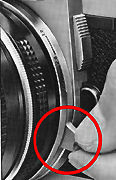 |
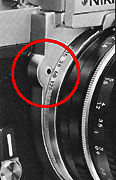 |
For example, f/8 gives twice as much exposure as f/ll. Shutter speed is expressed in seconds or fractions of a second. The numbers on the Nikkormat shutter-speed scale are reciprocals of the actual speeds (250 represents 1/250 second, etc.). |
Camera aperture and shutter-speed controls are calculated so that an increase of one f/number compensates for a one-step decrease in shutter speed. For example, 1/250 at f/8 is equ*alent to 1/125 at f/11. The table below shows how aperture and shutterspeed are interrelated. All the combinations give the same exposure.
|
Inter-relationship between Shutter Speeds and Apertures |
|||||
|
Aperture |
f1.4 |
f2 |
f2.8 |
f4 |
f5.6 |
|
Shutter speed |
1/500 |
1/250 |
1/125 |
1/60 |
1/30 |
* Other helpful information in this PIM site relating to Depth of Field / Shutter Speeds and Aperture value.
The mechanical Nikkormat FT series bodies were designed differently with other 'conventional' Nikon bodies - as the shutter speed dial is actually a ring in front of the lens mount. It operates the same way as an Olympus SLR bodies such as the OM-1, OM2n or the current OM3 and OM-4Ti (Where such unique operational control remains the same since the original debut of the OM-1 in 1972).
The key advantage is, while your index finger is resting fulltime at the shutter releasse button. Your left hand controls everything from focus, adjusting the aperture and turning the shutter speed ring. Since the three rings have different textures, feel and location, you can easily distinguish the three control rings with your hand. Well, a not so convenient part is - it is very unconventional if you are working mixed with a few new and older Nikon bodies. Anyway, if you have worked with a Nikkormat FT models, this should be easy to cope with but since the electronic EL series models present a closer resemblance of many other manual focus Nikon SLRs in control, levers and dials, it depends on your personal preference which model should you are comfortable with.
Setting the Shutter Speed
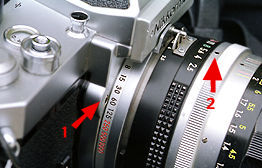 |
Caution: The three shutter speeds of 1/250, 1/500 and 1/1000 sec are all marked in red to remind you that these are out of flash synchronisation range. (What it means is - when using a flkash on your FT2, make sure the shutter speed is NOT set at these three settings - where partial black out in the eventual image will result). |
Note: The index for the shutter speed
is marked in black dot (1) (Near the lens mount of the camera
body), while the index for the aperture/distance (2)
is at diffferent location (on the lens).
Shutter speeds are controlled by a ring around the base of the bayonet mount rather
than the usual dial on top of the camera body. To set the shutter speed, grasp the
lever and turn the ring until the desired speed appears next to the indicator dot
on the front of the camera body. For added convenience when measuring exposure, the
shutter speed in use as well as the next highest and lowest speeds appear in the
bottom of the viewfinder, so the shutter speed can be adjusted while observing the
exposure meter needle.
Click-stopped settings for shutter speeds from 1/1000 to 1 second plus "B"
are engraved on the shutterspeed ring. At the "B" (bulb) setting, the shutter
remains open as long as the shutter release button is depressed.
Note: Intermediate shutter-speed settings
are NOT recommended except in the 1/250
to 1/1000 second range.
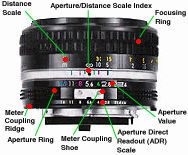 |
Setting the Aperture |
Note: As many Nikon service centres do not offer any AI conversion for your older Nikkor lenses anymore, you may have to search around for a reliable service centres that still offer AI modification of Non-AI lenses.
The FT-2 works with most
manual focus Nikkor lenses (except the Series E lenses) to provide proper metering
functions. But since all autofocus Nikkor lenses are not provided with a meter coupling
prong anymore (As with the Nikon Series E lenses), it is not advisable to try mouting
a AF lenses on your FT2. Theoretically, it is still possible to add one on those
lenses or use stopped down expsoure measurement method. (But just not worth the trouble).
But there are perhaps hundreds of thousand of such Nikkor optic on the used market,
I don't think it is impossible to find a suitable lens to fit your budget for your
FT-2.
EXPOSURE MEASUREMENT
The Nikkormat FT2 features a center-weighted thru-the-lens
exposure metering system
cross-coupled to the shutter speed and aperture controls. The meter reads the light
over the entire focusing screen but favors a central area (Around the ratio of 60/40,
where the central 12mm circle will have 60% emphasis on metering). This means that
correct exposures are quite safe even in situations where an averaged reading would
result in wrong exposure - with strong backlighting, for example.
Full-Aperture Exposure Measurement
The FT2 meter takes advantage of automatic diaphragm feature of Nikkor Auto Lenses to measure light at the maximum aperture of the lens. This insures a bright viewfinder image for viewing and focusing and minimizes the influence of light entering through the finder eyepiece.
 |
In order for the FT2 meter to measure exposure at full aperture with lenses of different maximum aperture, it must be coupled with the maximum aperture of the lens in use. This is done each time the lens is attached or changed by turning the aperture ring of the lens through its entire range. What it means is, you have to make sure you have a Nikkor lens that has a meter coupling shoe to fit in the meter coupling pin on the camera body to perform proper maximum aperture metering. Secondly, you have to set the maximum aperture of the lens in use at the side (1) (from f1.2, f1.4 and f5.6). |
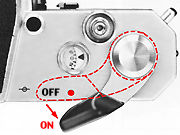 |
Turning On the Meter |
A number of different shutter speed-aperture combinations will usually result in the same exposure. The "best" one depends on the results desired. Use fast shutter speeds to "freeze" motion or slow ones to create deliberate blur. Small apertures give greater depth of field, large ones let the subject stand out against an out-of-focus background. If you want to understand more the relation and the respective effect yields with the apertures and shutter speed, < Click Here >. There are some related articles written by a friend of mine for Canon Marketing (If you are a die hard Nikon fan, please don't click... I am a Nikon user but not a 100% follower. In photography, regardless of brand names and types, the basic principle of the medium is the same).
| Previous | Next
Part 2/5
| Back
|
to Index Page of
Nikkormat FT-2 |
Back | to Main Index Page of Nikkormats
History
& Background
of Nikkormat Cameras
"Nikomat" Picture Library
of Japanese local version
Outline
the
major
key features and differences
of various models
The
Camera Bodies
| FT | FS | FTn | EL | FT2 | ELW | FT3 | EL2
This
site is made out 15.5MB with 478 items
(Jpeg, Gif, PDF & HTML files) (Last Update: 25th May 1999)
| Main Reference
Map
|
HTML Format: FT | FS | FTn | EL | FT2 | ELW | FT3 | EL2 | AW-1 Motor Winder
PDF Format: FT
| FS | FTn | EL | FT2 | ELW | FT3 | EL2 | AW-1 Motor Winder
| Specifications |
FT
| FS | FTn | EL | FT2 | ELW | FT3 | EL2
History
& Background
of Nikkormat Cameras
"Nikomat" Picture Library
of Japanese local version
Outline
the
major
key features and differences
of various models
The
Camera Bodies
| FT | FS | FTn | EL | FT2 | ELW | FT3 | EL2
| Main Reference
Map
|
HTML Format: FT | FS | FTn | EL | FT2 | ELW | FT3 | EL2 | AW-1 Motor Winder
PDF Format: FT
| FS | FTn | EL | FT2 | ELW | FT3 | EL2 | AW-1 Motor Winder
| Specifications |
FT
| FS | FTn | EL | FT2 | ELW | FT3 | EL2
| Message
Board
| for your favourite Nikkormats
| Message Board |
for your Nikon Optics in a shared environment
| Message Board |
Specifically for Dispose or Looking for Nikon/Nikkor Photographic
Equipment
 |
The Eyes of Nikon:- |
Fisheye-Nikkor Lenses - Circular | Full Frame | Ultrawides Lenses - 13mm15mm18mm20mm | Wideangle Lenses - 24mm28mm35mm |
Standard Lenses - 45mm 50mm 58mm | Telephoto Lenses - 85mm105mm135mm180mm & 200mm |
Super-Telephoto Lenses - 300mm 400mm 500mm 600mm 800mm 1200mm |
Special Application lenses:
Micro-Nikkor Lenses - 50mm~55mm -60mm 85mm -105mm 200mm Micro-Zoom 70-180mm
Perspective Control (PC) - 28mm 35mm PC-Micro 85mm
Dedicated Lenses for Nikon F3AF: AF 80mm f/2.8 | AF 200mm f/3.5 EDIF
Depth of Field Control (DC): 105mm 135mm
Medical Nikkor: 120mm 200mm
Reflex-Nikkor Lenses - 500mm 1000mm 2000mm
Others: Noct Nikkor | OP-Nikkor | UV Nikkor 55mm 105mm | Focusing Units | Bellows-Nikkor 105mm 135mm
Nikon Series E Lenses: 28mm35mm50mm100mm135mm | E-Series Zoom lenses: 36~72mm75~150mm70~210mm
MF Zoom-Nikkor Lenses: 25~50mm | 28~45mm | 28~50mm | 28~85mm | 35~70mm | 36~72mm E | 35~85mm | 35~105mm | 35~135mm |
35~200mm | 43~86mm | 50~135mm | 50~300mm | 70~210mm E | 75~150mm E | 80~200mm | 85~250mm |
100~300mm | 180~600mm | 200~400mm | 200~600mm | 360~1200mm | 1200~1700mm
Tele-Converters: TC-1 | TC-2 | TC-200 | TC-201 | TC-300 | TC-301 | TC-14 | TC-14A | TC-14B | TC-14C | TC-14E | TC-16 | TC-16A | TC-20E
![]()
Nikon F
| Nikon F2 |
Nikon
F3
| Nikon F4 |
Nikon
F5
| Nikon F6 |
Nikkormat / Nikomat |
Nikon FM
| Nikon FE/ FA | Nikon EM/FG/FG20 | Nikon Digital SLRs | Nikon - Other models
MIR Supports for Photographic Community: Various Message Boards/Community
Forums
Nikon
F-series|
Nikon
F2-series|
Nikon
F3-series|
Nikon F4-series| Nikon
F5-series|Nikkormat/Nikomat-series
Nikon FM-series|Nikon
FE-series|Nikon
FA|Nikon
Digital
SLR
series|Various
Nikon
Models|Nikkor
Optic
-shared
Others:- Free Trade Zone - Photography| Free Trade Zone - Business Community |Free To Zouk - Photographic Community
Apple's Mac Public Community Message Board | Windows based PC &
Apple/Mac
Public Community Trade Exchange Centre
Recommended links to understand
more technical details related to the Nikkor F-mount and production Serial Number:
http://rick_oleson.tripod.com/index-153.html by: my friend, Rick Oleson
http://www.zi.ku.dk/personal/lhhansen/photo/fmount.htm by: Hansen, Lars Holst
http://www.mir.com.my/rb/photography/hardwares/nikonfmount/lens2.htm
http://www.photosynthesis.co.nz/nikon/serialno.html
About
this photographic
site.
Home - Photography
In Malaysia
![]()
Copyright
© 1998.
HIURA Shinsaku ® ; Nikomat ML, Japan,
in collaboration with leofoo ®. MIR Web Development Team.
* Credit: A
Great thanks to Mr Denis Pleic for his volunteering
effort to reedit content and and patching some grammatical mistakes found in this
section of the PIM site. Miss
Rissa (Marketing) & Edward
(Techical) of Shriro Malaysia, distributor of Nikon cameras in Malaysia, in providing
so many useful inputs to make this site possible. Mr Hong,
Ipoh for lending me his FT2 to take some of the images used in this site. This site
is created for his eldest son, Yuen who has picked up his father's hobby and
the FT-2. My friend, John Walls from Florida, US for his images of the FTn
body and the Zoom Nikkor
43-86mm.
[Left Brain][Right brain][Home-MIR] [Invention][Art & Design][Clubs]
[Portfolios][On assignments] [Trading room][Knowledge & Resources] [Free-trade-zone][Thoughts & opinions][Links]